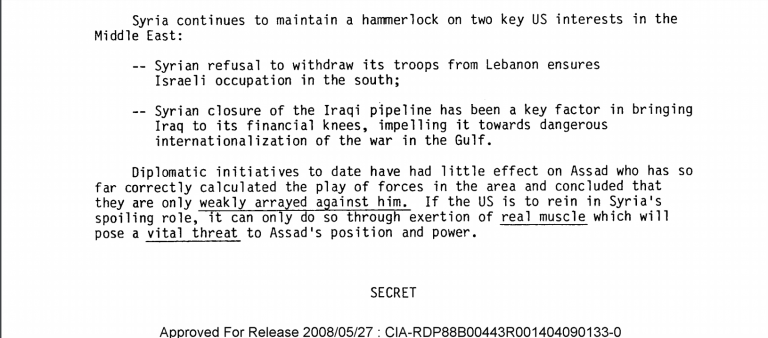A CIA document from the early 1980s details a US plan to destroy Syria — in much the same way the United States has been doing for the last few years.Geostrategically crucial Syria has been at the center of a decades-long plot by the United States to depose the sovereign government and install one supportive of goals in the Middle East must be revisited — and quickly — before the beating of war drums drowns out the truth of our government’s recently-espoused mission. President Donald Trump has repeatedly castigated President Bashar al-Assad for ordering a gruesome mass killing of civilians with chemical weapons in Khan Sheikhoun. This accusation sparked a bolstering of support for the Syrian regime from both Moscow and Tehran. “Syria at present has a hammerlock on US interests both in Lebanon and in the Gulf — through closure of Iraq’s pipeline thereby threatening Iraqi internationalization of the war. The US should consider sharply escalating the pressures against Assad through covertly orchestrating simultaneous military threats against Syria from three border states hostile to Syria: Iraq, Israel and Turkey.” While the preceding bears the names of leaders and nations familiar to current headlines, that assessment, cogently titled, “Bringing Real Muscle to Bear Against Syria,” from former CIA officer Graham Fuller in actuality discusses Syria under Assad’s predecessor — his father, Hafez al-Assad — and is dated September 14, 1983, amid the Iran-Iraq War. [pdf-embedder url=”https://commonsenseevaluation.com/wp-content/uploads/2017/04/CIA-RDP88B00443R001404090133-0.pdf”] As the six-page document continues,
With Iraq seeking to enjoin support internationally in the war, the U.S. had to scramble to prevent the shutdown of a pipeline — a dilemma Fuller suggests could be alleviated through a change in narrative to present Syria as a more deviant enemy than even Iran. That, alone, would have changed the face of the war bearing the names of the two principal adversaries — Sunni majority, Iraq, and Syria-allied, Shi’a, Iran. Fuller asserted, “The US should consider urging Iraq to take the war to the other key source of its predicament: Syria.” Further, he continued, “The US should consider sharply escalating the pressures against Assad [Sr.] through covertly orchestrating simultaneous military threats against Syria from three border states hostile to Syria: Iraq, Israel and Turkey. Iraq, perceived to be increasingly desperate in the Gulf war, would undertake limited military (air) operations against Syria with the sole goal of opening the pipeline. Although opening war on a second front against Syria poses considerable risk to Iraq, Syria would also face a two-front war since it is already heavily engaged in the Bekaa, on the Golan and in maintaining control over a hostile and restive population inside Syria. “Israel would simultaneously raise tensions along Syria’s Lebanon front without actually going to war. Turkey, angered by Syrian support to Armenian terrorism, to Iraqi Kurds on Turkey’s Kurdish border areas and to Turkish terrorists operating out of northern Syria, has often considered launching unilateral military operations against terrorist camps in northern Syria. Virtually all Arab states would have sympathy for Iraq. “Faced with three belligerent fronts, Assad would probably be forced to abandon his policy of closure of the pipeline. Such a concession would relieve the economic pressure on Iraq, and perhaps force Iran to reconsider bringing the war to an end. It would be a sharpening blow to Syria’s prestige and could effect the equation of forces in Lebanon.” In context, then-President Ronald Reagan faced pressure both to insert military power in Lebanon — a theater of stated neutrality for the U.S. — and to prohibit actual military assistance in the fraught regional entanglement. That is, until a suicide bomber decimated a U.S. Marines barracks encamped at an airport in Beirut, killing hundreds — just one month subsequent to the date on Fuller’s Syria action plan. Micah Zenko, Senior Fellow at the Council on Foreign Relations — an albeit establishment- and Deep State-connected think tank — in “When America Attacked Syria,” wrote in 2012: “The October 23, 1983, suicide truck bombing of the Marine barracks at the Beirut International Airport would kill 241 U.S. military personnel; simultaneously, another suicide bomber killed fifty-eight French servicemen of the MNF several kilometers away. (Two weeks later, yet another truck bomb exploded in the Israeli military headquarters in Tyre, killing sixty.) A FBI forensics assessment called the Marine barracks bombing the ‘biggest non-nuclear explosion since World War II.’ According to a Pentagon commission formed to investigate the attack, it was ‘tantamount to an act of war using the medium of terrorism.’ Within weeks, the CIA determined that ‘the bombings…of the United States and French MNF headquarters were carried out by Shia radicals, armed, trained, and directed by Syria and Iran.’” That the CIA — master meddler in the affairs of sovereign nations — determined fault for the bombings rested with Syria and Iran left both plausibly responsible, with public perception largely following suit. That a situation eerily similar — in behind-the-scenes string-pulling and long-term U.S. commitment to deposing an Assad from rule in Syria — appears to be playing out nearly three-and-a-half decades later, bellows resoundingly on failures of interventionist foreign policy. Or, perhaps, its successes. “Such a threat must be primarily military in nature. At present there are three relatively hostile elements around Syria’s borders: Israel, Iraq and Turkey. Consideration must be given to orchestrating a credible military threat against Syria in order to induce at least some moderate change in its policies,” Fuller explained in the document. “This paper proposes serious examination of the use of all three states – acting independently – to exert the necessary threat. Use of any one state in isolation cannot create such a credible threat.” Syria is now a landmine for the Trump administration — as it has been in varying intensity for a lengthy succession of presidents before.
|
Apr 122017


Sorry, the comment form is closed at this time.